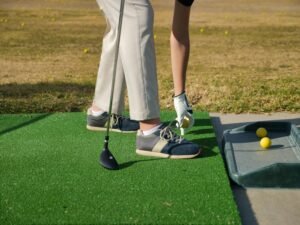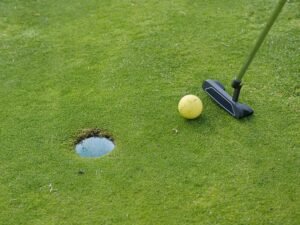
I hope you enjoy reading this blog post.
If you are looking professional golf manufacturer.
Golf Safety Guide: Enjoy The Fun Of Swinging And Build A Strong Safety Line
March 14, 2025
Golf, this elegant and competitive sport, with its unique charm, attracts many lovers to enter the green course. In this vast and quiet world, a journey of intimate contact with nature and self-challenge is slowly unfolding.
However, when it comes to enjoying the pleasure and relaxation that golf brings, safety is always a top priority and there is no room for slack.
Whether it is a novice beginner, or a veteran player who has experienced many battles. Safety awareness should be deeply rooted in the heart, strictly follow the safety guidelines.
Only in this way can we fully appreciate the infinite charm of golf while ensuring the safety of ourselves and others.
Before Batting: Full Preparation, Prevention
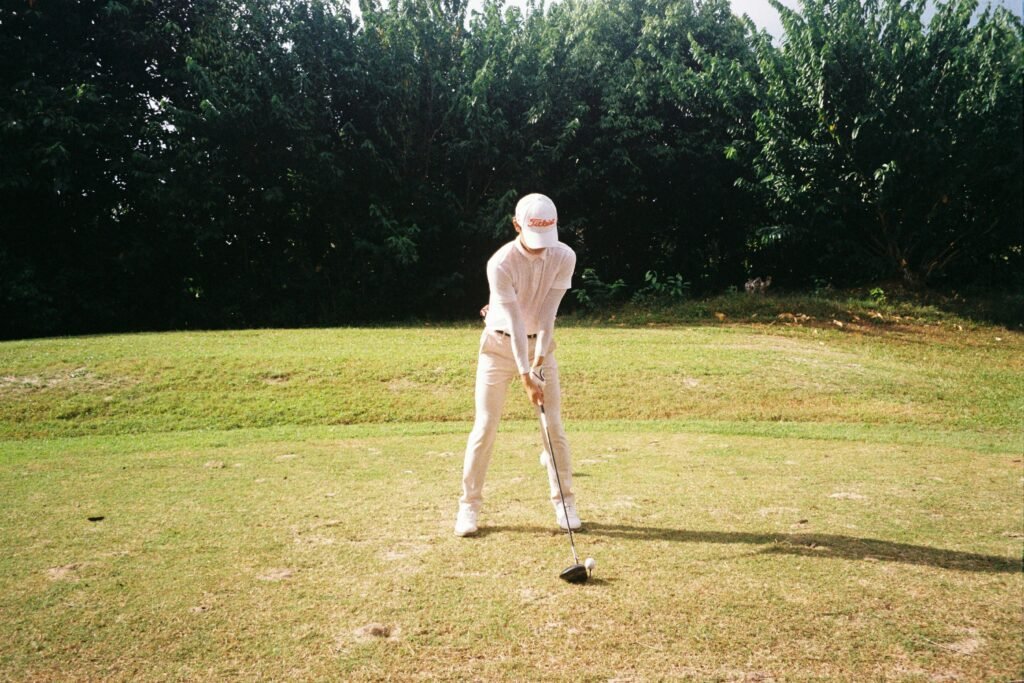
Canvass The Site
Before hitting the ball, be sure to observe the hitting area and the possible flight path of the ball in all directions. Look like professional security equipment, do not let go of any corner.
Make sure that the front, left, right, and surrounding areas are clear of people, vehicles, and any obstacles that could block the ball’s flight or cause an accident. The terrain of the golf course is often complex and diverse, some undulating, some wooded, which are easy to form a blind spot.
In the face of this difficult terrain, we must be vigilant. Repeatedly confirm the safety situation, must not rush to hit the ball, so as not to cause unpredictable danger.
Match The Club Exactly
Choose the right club accurately according to your physical condition, technical level and current batting needs. This is the key to ensuring the safety and effectiveness of the shot. The club, like a weapon in the hand of a warrior, must be perfectly adapted to the user.
If the club does not match its own conditions, it is like driving a car of inappropriate size, which is very easy to cause accidents.
For example, if the club is too long, the swing will be like a whip out of control, and it is difficult to control the direction. If the rod head is too heavy, it seems to be carrying a heavy burden, and the slightest mistake may sprain the wrist and pull the muscle.
Warm Up
A good warm-up exercise is an essential safety guarantee before playing golf. Think of yourself as an athlete who is about to perform on stage. You need to move every joint in your body, wake up every muscle, and make your body fully prepared.
When warming up, focus on key areas such as the shoulders, waist, wrists and knees. These parts are frequently active in golf and are prone to injury. Specifically, there are the following points to note:
Reasonable control of intensity: the intensity of warm-up exercise should be moderate to avoid excessive fatigue. Start with simple joint movements and gradually increase the intensity of the exercise.
For example, first perform easy shoulder rotation, waist twisting, and exercise the shoulder and waist joints. Then slightly more intense arm swing and leg flexion and extension, each action repeat 10-15 times, with the body slightly warm, relaxed is appropriate.
Make sure you do it properly: Each warm-up should be in position to ensure that your body is fully stretched.
For example, when performing a waist twist, the feet should stand firmly, turn slowly and smoothly with the waist as the axis. The range should be moderate to avoid straining the waist due to too much action and too fast speed. Standardized movements can not only effectively prevent sports injuries, but also improve the warm-up effect.
Follow the gradual principle:the warm-up time should not be too short, and do not suddenly warm up with high intensity.
It is recommended to control the warm-up time at 10-15 minutes, so that the body has a gradual adaptation process. Start with about five minutes of slow walking or light aerobic exercise.
Such as jumping jacks, let the body sweat slightly, speed up blood circulation, and then carry out targeted joint and muscle stretching.
Combine the characteristics of the sport: the warm-up should be as closely related to the golf stroke as possible.
For example, to simulate the swing action, start with a slow air swing, and feel the force and movement trajectory of various parts of the body during the swing. Gradually build up your speed and prepare yourself for batting in advance.
This warm-up allows the body to better adapt to the movement pattern of golf and reduce the risk of injury.
Through a comprehensive and effective warm-up, the muscles become soft and elastic, and the joint range of motion is more flexible.
Thus effectively prevent muscle strain, sprain and other sports injuries that may occur in the process of batting. Lay a good foundation for subsequent batting activities.
Batting: Standardize Operation And Control Risk
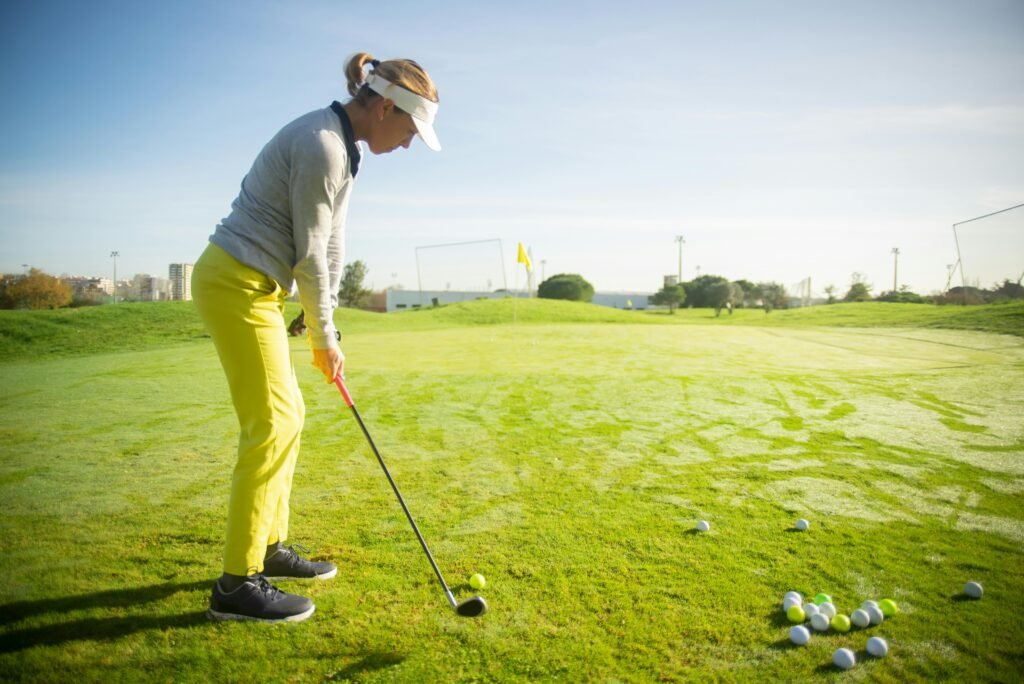
Hold Standard Posture
Maintaining the correct batting posture and stable standing posture is like laying a solid foundation for a tall building. This is not only the key to improving the quality of the ball, but also an important factor in reducing the chance of physical injury.
The correct posture can make all parts of the body coordinate the force, so that the hit is more accurate and powerful. The wrong posture is like a leaning building, which can “collapse” at any time.
Twisting your body too much can put a lot of pressure on your waist and back. Like an overburdened bridge, it can easily cause injuries to the lower back and waist. Too much force, it will be like a runaway machine, causing serious injuries to the shoulder and arm.
Therefore, during the batting process, we must always pay attention to maintaining the standard posture.
Precise Control Of Your Swing
When swinging, be like a careful swordsman, always paying attention to the space around the club. Ensure sufficient safe distance to avoid collision with others or obstacles.
At the same time, the force and amplitude of the swing should be accurately controlled, just as the throttle and steering wheel are accurately controlled when driving a car. Too much or too little strength, the amplitude is not appropriate, may lead to batting mistakes. Even let the club out of the hand, causing unexpected danger.
During the swing, it is necessary to concentrate and adjust the swing according to the actual situation to ensure the safety and accuracy of the stroke.
Eliminate Potential Accidents
Before hitting the ball, be careful to ensure that the ball is placed steadily as if you were checking a precision instrument. Avoid sudden rolling or popping of the ball at the moment of hitting the ball, causing unpredictable flight trajectories.
Also, never use a club or ball that is visibly damaged or deformed. A damaged club can break suddenly when hitting the ball, and a deformed ball can cause a loss of direction. They are like time bombs hidden in the dark, which can affect the batting effect at any time, and even endanger safety.
Before each shot, carefully check the state of the club and the ball to ensure that it is in good use.
After Hitting: Keep An Eye On It And It's Over Safely
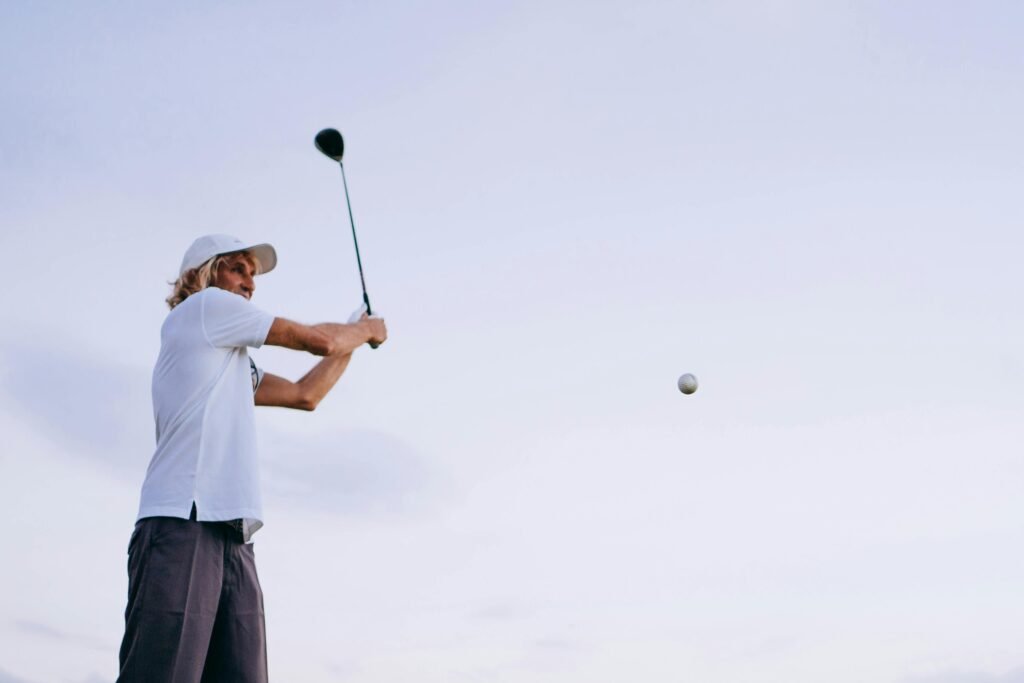
Keep An Eye On The Spot
After hitting the ball, the eye should follow the flight path of the ball like tracking radar, and pay close attention to the landing point of the ball. Quickly determine if the ball poses a threat to other people or objects.
As soon as you notice that the ball is likely to fly to nearby people or enter a dangerous area, shout out immediately. Send a clear, loud warning to remind others to take shelter.
This is not only responsible for the safety of others, but also an important measure to ensure the safety and order of the entire stadium.
Wait Patiently For The Ball To Stop
While the ball is still rolling, be like a patient hunter waiting for his prey to settle. Do not rush to approach. The rolling trajectory of the ball is full of uncertainty, and it can suddenly change direction or bounce back at any time, causing injury to those who approach.
Be sure to wait for the ball to come to a complete standstill before moving steadily towards the ball’s landing spot. This seemingly simple waiting is actually a key step to avoid accidents, and it must not be rushed.
Walk With Caution
When walking towards the ball’s landing spot, pay attention to the terrain of the course as if you were walking on a road full of traps.
Especially in the sand pit, slope, water side and other dangerous areas, the ground condition is complex. If you are not careful, you may slip, fall or fall into soft ground. Keep your feet steady, keep your eyes on the road, and always be alert to make sure you reach the ball safely.
During the walk, don’t get distracted. Focus on the road under your feet to avoid inadvertent accidents.
Avoid Disturbing Others
After reaching the landing point of your own ball, in the follow-up operation, you should always take care that your behavior does not interfere with the hitting line or vision of other players.
For example, do not distract others by walking in front of them as they prepare to hit the ball. Do not leave footprints or other marks on the green that may affect others’ shots. The green is a very critical area of the golf course, and keeping its surface smooth and clean is crucial to the player’s shot.
At the same time, if one’s ball lands on the rolling path of a ball already hit by another player. It should be signaled in time and properly handled without affecting others to ensure that the batting order of the entire court is not disturbed.
Check Equipment Condition
After hitting the ball, check the club for signs of damage or loosening while you change the club or take a break.
Especially after hitting the ball vigorously, there may be subtle damage to the joint of the club body and the club head. If not found and treated in time, it may cause the club to break during the subsequent stroke, resulting in danger.
At the same time, check the wear of the ball. Excessive wear of the ball flight trajectory may be unstable, affecting the effect of the shot, but also there are certain safety risks.
Check equipment regularly to find and solve problems in time. It is an important measure to ensure the safety and smooth progress of golf.
Other Points: Attention To Detail, Comprehensive Protection
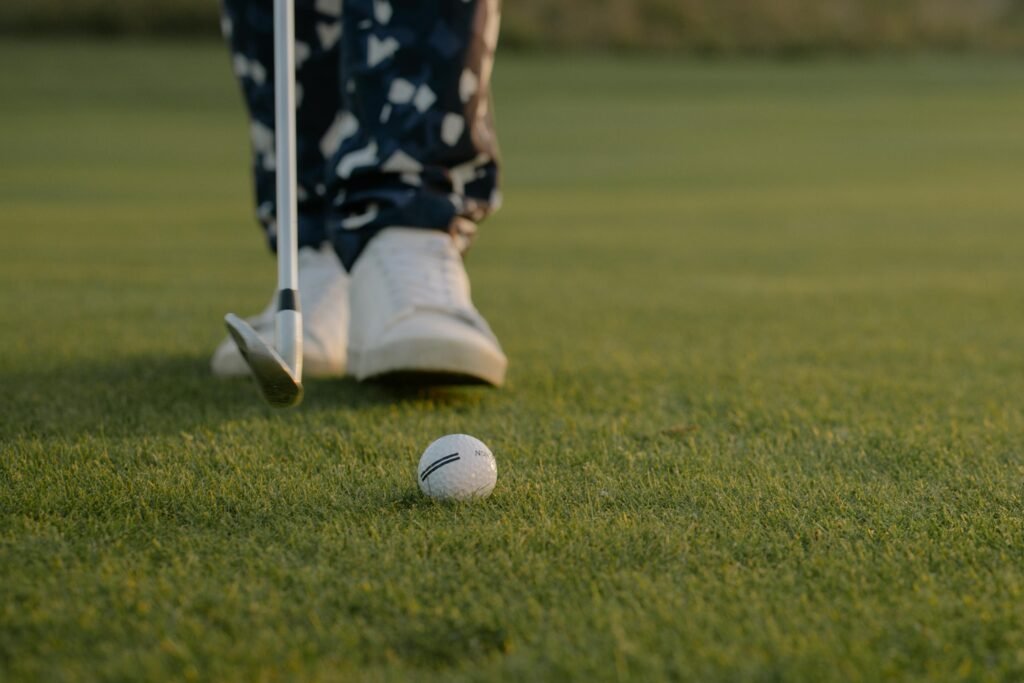
Stick To The Rules
It is just as important to follow the rules of the golf course and signs as it is to follow the rules of the road. Walk and play ball in accordance with the prescribed route, and do not enter the prohibited area at will.
Some courses have specific safety requirements based on different time periods and field conditions, such as prohibiting the use of certain clubs at certain times. For these requirements, be sure to strictly comply with, do not take chances.
Following the rules is not only a guarantee of your own safety and the safety of others, but also a respect for the etiquette and culture of the game of golf.
Scientific Response To Weather
The weather, like an unpredictable genie, has an important effect on the game of golf. In case of bad weather, such as thunderstorms, howling winds, torrential rain. You should immediately stop playing and quickly find a safe place to hide.
Never stop under a tree, near a telephone pole, or near water. These places can act as dangerous traps in bad weather, vulnerable to lightning strikes and other hazards.
Before you leave, pay attention to the weather forecast and prepare for different weather conditions in advance. In case of sudden bad weather, stay calm.
Follow the safety instructions of the course and the guidance of the staff, and quickly evacuate to a safe area.
Maintain Effective Communication
Maintain good communication and collaboration with the players in the same group, as a team. Alert each other before hitting to make sure it’s safe. If there is any doubt or uncertainty about the shot, promptly communicate with the players in the group or the course staff.
A simple reminder, a timely communication, can avoid a potential security incident. Good communication can not only improve the efficiency of playing, but also create a harmonious and safe playing atmosphere.
Focus On Special Groups
If there are children, the elderly or persons with mobility difficulties in the course, special attention and care should be given. Children may not have enough awareness of the dangers of golf and are easy to run on the course at will.
At this time to remind the guardian to pay attention to the safety of the child. Make sure your child is at a safe distance when hitting the ball.
For the elderly and people with reduced mobility. Avoid hitting the ball hard near them, so as not to deflect it and cause injury.
On the court, always maintain a sense of caring for others. Work together to create a safe and friendly environment.
Care For Stadium Facilities
On the course, take care of all the facilities, such as holes, tee signs, bunker rakes, etc. Random destruction of facilities will not only affect the normal use of the course, but also may bring safety risks to themselves and others.
For example, a damaged hole may cause the ball to become trapped in the hole, making it difficult to remove the ball. You can also accidentally sprain your finger while retrieving the ball. Broken tee marks can cause players to misjudge the position of the serve, causing unnecessary danger.
It is the responsibility and obligation of every golf enthusiast to care for the course facilities. It’s also an important part of keeping yourself and others safe.
Golf is a wonderful journey of dialogue with nature and self-challenge. In this charming field, safety is the premise for us to enjoy the fun of sports.
Let’s keep these safety considerations in mind and turn them into guidelines for every swing and every step we take.
Whether at dawn in the early morning or at sunset in the evening, you can rely on safety as the cornerstone. Enjoy the infinite charm of golf and make every golf trip a pleasant and memorable experience.
FAQS
How do I choose the right golf ball for my skill layer?
Beginners should start with two-layer balls for ease of use and affordability. Intermediate players might benefit from three-layer balls for better control.
Advanced players can explore four or five-layer options to enhance their performance.
Are more layers always better?
Not necessarily. While more layers can offer advanced performance features, they may not be suitable for every player.
Beginners might find multi-layer balls harder to control, while more experienced golfers can benefit from the added complexity.
What is Fuli lead time?
Usually, we ship orders in 2 weeks. But it will take a little longer if we have the heavy burden of production tasks. It also takes more time for customized products.
Can the weather affect the choice of golf ball?
Absolutely. In colder weather, a softer ball might provide better feel, while in warmer conditions, a firmer ball might maintain distance better.
Additionally, wet conditions may call for balls that offer better traction and control.
How often should I change my golf balls?
Golf balls should be replaced if they show visible signs of damage (scrapes, cuts) or if you notice a decline in performance.
Regular players may want to change balls every few rounds, while casual players can go longer.
Leave a Reply
Your email address will not be published. Required fields are marked *

Are you looking for
GOLF BALL?
Offers Suitable Golf For Wholesalers And Professionals










